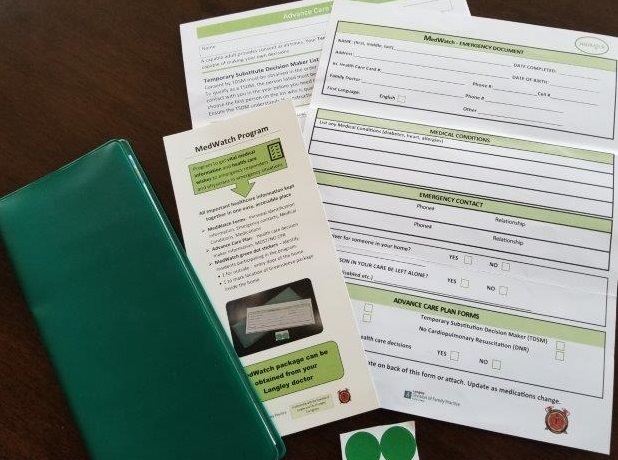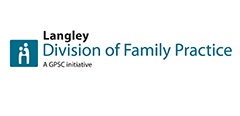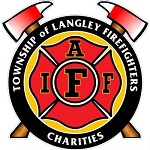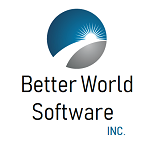The MedWatch Program
Making your wishes known in an emergency
- For all capable adults
Not just for seniors or those with multiple health concerns - Available at your doctor's office
Anywhere in Langley - Developed through community partnerships
With Langley doctors and firefighters
First Responders
Ensuring your vital medical information and health care wishes are available to Emergency Responders and Physicians in emergency situations
Decision Makers
If you cannot speak for yourself, who will speak for you? If you don't document who will speak on your behlaf, then the choice will be made for you
Healthcare Wishes
It is not enough to verbally inform your caregivers of your healthcare wishes. Your wishes must be document and presented in order to be honoured
Documents Together
All your vital information located in a single folder: Personal identification, emergency contacts, medical conditions, decision maker lists and MOST or NO CPR orders
How do I get the MedWatch package?
Call the Langley Division of Family Practice at 604-510-5081 or go to your local doctors office.
Most forms can be filled out on-line and printed from our website, so you don't need to get another Medwatch package when you need to make updates.

Want to join the MedWatch program?
Read through the program steps below and use the checklist to complete the program!
Let's get started now...

Visit Your Doctor
When calling to book your appointment
with your doctor or nurse practitioner,
explain the purpose of your visit
to allow enough time.
Doctors or nurse practitioners are only required to complete the MOST (Medical Order for Scope of Treatment) or No CPR forms. The Doctor or Nurse Practitioner can help with understanding choices for treatments, interventions and potential outcomes.
Talk about what your health might look like in the future.
-
Explain types of treatments that might be used to make informed decision.
-
What proposed treatments may be offered to me and how might the treatments improve or worsen my daily life?
-
Discuss options for care at the end of your life.
-
Talk about the MOST and NO CPR forms.
MOST
Medical Order for Scope of Treatment
Although you will always be asked to give your own consent for health care treatment as long as you are able, with illnesses many lose the ability to decide or speak on their own behalf.
-
If you cannot speak for yourself for health care decisions, your MOST order can direct your care.
-
Symptom management is always provided. Level of intervention is based on goals of care based on documented conversations.
NO CPR
No Cardiopulmonary Resuscitation
CPR is only done if both your heart and breathing stop.
-
CPR is used to restart your heart and breathing with machines and/or chest compressions.
-
CPR can work for fairly healthy adults, if started right away.
-
If No CPR is chosen you will continue to get medical care to treat symptoms to keep you comfortable.
Place a copy of your MOST or NO CPR orders in your greensleeve
Pick your Decision Makers
Advanced care planning starts with determining your beliefs, values and wishes for future health care treatment, communicating your wishes to close family and friends, and documenting your choices in the event you become incapable of making your own decisions.
Personal Reflections

Patients have goals other than just living longer
Answers to the following questions will assist health care providers to help you decide what future health care treatments you would or would not accept.
What you your goals and priorities? Health and other? i.e. granddaughters wedding or graduation, watch baseball and eat ice cream.
-
What gives you joy? Provides your life with meaning and fullfillment? ie. hobbies, time with family, etc.
-
What are your fears? ie. being a burden on family, struggling to breath.
-
What abilities are critical, something you can't imagine living without? ie. being able to communicate with others
-
What would you not want to have done or go through? ie. being kept alive by machines with no chance of recovery
-
What are you willing to go through for more time? What trade offs are you prepared to make?
Starting the Conversation with
Family or Designated Decision Makers
An advance care plan lets you share your wishes with others so you will get the care you want and they have the confidence to make the decisions for you when you can't.
I want you to be prepared if you had to make a decision on my behalf.
-
It's important to me family can understand and honor my wishes.
-
I want you to know what my health might look like in the future, and I want you to be prepared and make it easier if you had to make decisions on my behalf.
-
I would like you to go with me to medical appointments, to help understand my health care wishes.
Giving Others Decision Making Authority
There are different types of legal documents in BC that give others decision making authority over various aspects of your life.
Below is a summary of the key documents you should be aware of.
Enduring Power of Attorney
Allows you to appoint another person to make decisions regarding financial and legal affairs only. POA requires a Lawyer or Notary to complete.**No healthcare decisions can be made.
Representation Agreement
Allows you to provide a list of capable adults to be representatives to make healthcare and other decisions on your behalf. The people listed in your representation agreement will only be asked to make decisions for you if you are unable to speak for yourself! There are two types of agreements: Standard and Enhanced.**Form must be printed and witnessed by two people.
Standard Representation Agreement section 7RA
Allows your representative to make decisions about routine management of your financial affairs, personal care and some healthcare treatment decisions.**Does not allow Healthcare decisions for you that involve refusing life support or prolonging medical interventions.
Enhanced Representation Agreement section 9RA
Allows you to authorize a representative to make personal care and Healthcare decisions on your behalf.**This includes decisions about the acceptance or refusal of life support and life prolonging medical interventions.
If you have not legally documented
your decision makers, a temporary
decision maker will be assigned to you.
Place a copy of your representation agreements in your greensleeve
STEP 1 - Fill Out MedWatch Form

Open, complete, and print the MedWatch Emergency form.
or
Print the blank MedWatch Emergency form and follow the instructions below.
-
Complete the Personal Identification section of the document. Make sure to include your name, your Personal Health Number (PHN) (which should be entered into the BC Health Care Card # field), and your family doctor.
-
Document all medical conditions in the Medical Conditions section of the form. Make sure to include as much detail as possible, as this information could affect your care in an emergency situation.
-
In the Emergency Contact section include a local contact available to come and help you in an emergency situation and who could secure your home if you are unable to. Someone who lives close by is ideal.
-
If you are a caregiver, complete the Caregiver section.
-
If you have forms in your greensleeve that the emergency responders should access, complete the Advance Care Plan Forms section. Make sure to check off which forms should be in your greensleeve.
-
Complete the Medications section
- Your Pharmacist can print your list of medications. Attach your medications list to the form.
- Update the list each time you get a new medication or a change in your medication.
- Review the list frequently and add a reminder to your calendar to review in 6 months.
STEP 2 - Document Decision Makers

If you have a Representation Agreement, you already have a decision maker,
and can skip this step if you like. However, filling out the Temporary Substitute Decision Makers (TSDM) form will make it easier for first responders to contact your family . They will have immediate access to contact information for people you would like to make decisions on your behalf.
If you do not have a
Representative Agreement with
someone, your health care decisions
will be made by the people listed
on your Temporary Substitute
Decision Makers form.
Open, complete and print the Temporary Substitute Decision Maker form.
or
Print the blank Temporary Substitute Decision Maker form and follow the instructions below.
-
Complete the Personal Identification section at the top of the form. Make sure to include your name and the date you filled out this form.
-
Complete the Temporary Substitute Decision Maker List section of the form. Enter a name and contact number for the following decision makers:
- Spouse
- Adult children
- Parents
- Brothers or sisters
- Grandparents
- Grandchildren
- Anyone else related by birth or adoption
- A person immediately related by marriage
- Close friend
-
If there is a person you don't want involved in your health care decisions, make sure to include them in the last section of the form.
The Temporary Substitute Decision
Maker form is only used if you are not
capable of making your own decisions
Place a copy of your TSDM form in your greensleeve
STEP 3 - Place Copies in Greensleeve

-
Place documents in greensleeve
Copies of the following forms should be placed in the greensleeve:
- MedWatch Emergency Document
- Temporary Substitute Decision Maker Form
- Representation Agreements
- MOST form **
- No CPR form **
** must be signed and dated by your doctor
STEP 4 - Make Your Package Available

The next steps are critical to
ensure your greensleeve package
is found by emergency responders!
In Langley, emergency responders are trained to look for a green sticker on your apartment or front door. If they see a sticker on your door, they will then look for the other green sticker in your kitchen.
-
Put Greensleeve in Safe Place
Choose a location that will be accessible to emergency workers when they arrive. Some common places to store your folder would be in a cupboard, drawer or on your fridge.
-
Apply Green Sticker Inside Home
Apply one green sticker to mark the location of the Greensleeve package inside the home. Apply to the outside of the fridge, cupboard or drawer.
-
Apply Green Sticker Outside Home
Apply one green sticker outside the entry door of the residence. Apply to front door of house or personal apartment door.
-
Mark Your Calendar
Mark your calendar for 6 months to update your documentation. Make sure to make changes to your documents if your medications change.
You have now completed your MedWatch package!
Need more help?
If you want help filling out your MedWatch forms or understanding more about the program, Meals on Wheels provides volunteers that will come to your home to help you fill out your MedWatch package and explain the program to you.
You can contact Langley Meals on Wheels directly or call us at Langley Division of Family Practice at 604-510-5081.
Upcoming Events
About Us
The Langley Division of Family Practice has partnered with Langley physicians, hospital emergency department, emergency responders, senior living residences and community organizations to implement a community wide health care emergency MedWatch Program, for all of Langley, BC.
Our Partners

Our Mission
The MedWatch Program was developed out of the need to get vital medical information and health care wishes to emergency responders and physicians in emergency situations. Our goal is to address these challenges and provide first responders access to medical information to help them assess and treat patients.





